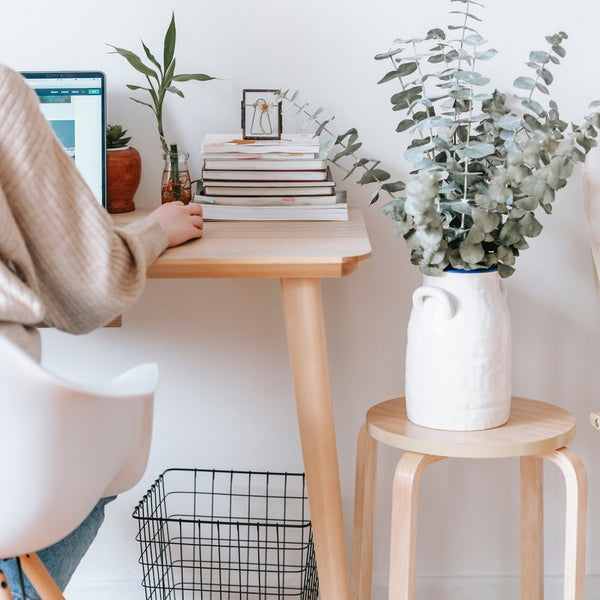Dos & Don'ts for Creating a Child's Workstation at Home

Countless aspects of life have been reinvented since the pandemic, especially kids and how they learn. As some schools gradually attempt reopening, many are still remote learning, while others are trying a combination of the two. Far from easy, the change in routine can be stressful for both parents and children. One of the beautiful things about kids is, they’re flexible and resilient. With awareness, you can increase your child's capacity for learning by designing a workstation aimed at lessening distractions and enhancing productivity. Hopefully, in the process, you can free up some time for yourself.
Attention Spans & Shifting Gears

For some insight on the subject, I spoke with Dr. Roseann Capanna-Hodge, School Psychologist, and co-author of Brain Under Attack. “The biggest learning hurdles parents face when children study at home is getting a child to start their work and stay focused,” says Dr. Capanna-Hodge. Working at home involves shifting a child's mindset. “It is easy to lose that structure that helps children transition from one activity to another, so staying engaged is a real struggle. With so little instruction, kids are also having a hard time learning new concepts and completing the work,” says Dr. Capanna-Hodge.
Emotional Security

What elements encourage a feeling of safety? “When we allow children to help create their own learning environment, they have a greater sense of control, safety, and most certainly of ownership. Have children pick out the elements that go in their space but also include items that calm their busy minds such as fidget toys, sensory seat cushions, play dough, etc,” says Dr. Capanna-Hodge.
Brain Recharge

Since children experience so much stimuli online, and can easily be pulled in various directions, taken away from school work, does it make sense to limit time online? According to Dr. Capanna-Hodge, “The key to avoiding the digital brain drain is taking breaks and getting some movement. The brain experiences fatigue after just 20 minutes of screen usage so taking eye breaks, wearing blue blocker glasses, and standing up and taking a stretch are tactics to combat that digital brain drain.” To keep your child engaged, switch up how you work together. For instance, try instructing your child to write longhand to engage different areas of his/her brain. “Taking pen to paper is also a technique to engage a different brain muscle and for those kinesthetic learners may help to deepen learning,” says Dr. Capanna-Hodge.
Awaken Creativity

In addition to study, allow time to enliven the imagination. “Have creativity boosters accessible like chalkboards, colored makers, corkboards, and other tools that give your brain free space to think outside the box. Moreover, making time on your schedule for brainstorming and more imaginative creations keeps you stimulated,” says Dr. Capanna-Hodge.
Gain Clarity

What's a good way to minimize distractions? “Reduce clutter and have things organized in a logical way so you don't have to dig through the clutter to find what you need. Cleaning off your desk and having just the things that are most essential makes it easier to focus without being distracted,” says Dr. Capanna-Hodge.
There are myriad ways to paint a calming picture. “Adding an essential oil diffuser, a weighted blanket or a comfy chair are great additions to encourage time for mindfulness throughout the day. These items help to regulate the nervous system, which means not only would one feel calmer but it increases focus as well,” according to Dr. Capanna-Hodge. Consider Brentwood Home’s new Eco-Comfy new seat cushion; made of either charcoal infused memory foam, or organic latex. While melding to your body's unique contours, it also helps naturally purify.
Health & Comfort

For a health/design perspective, I spoke with Jamie Gold, Wellness Design Consultant. What should a parent avoid when setting up a child’s work area? “A lack of task lighting potentially creates headaches, or a computer that isn’t properly positioned to the child’s height and reach,” says Gold.
Allow for freedom of movement and flexibility in the work space. “A parent should look for adjustability whenever possible, (especially if more than one child is rotating through a study space) so that the child’s learning zone fits his or her body,” says Gold.
Siblings & Study Time

What about a workspace used by more than one child? “I’d suggest color-coded organizers and supplies for children sharing a study space. Let each choose one favorite color and keep their papers and school supplies separate so there’s less chaos or disagreement over whose items are whose,” says Gold.
Wellness & Hygiene
In addition to hand washing, and regular cleaning, there are various ways to protect your little ones from getting sick. According to Gold, “Reducing germ spread with touchless technology can be helpful. This can be done with light switches, faucets and other heavily-shared items.” Air quality is important too, especially as winter sets in. Gold says, “Consider adding air purifiers, high efficiency air filters, radon and carbon monoxide detectors, and plants to your home for the months ahead.”
For more helpful home/study tips, check out Gold’s book, Wellness by Design: A Room-by-Room Guide to Optimizing Your Home for Health, Fitness and Happiness



